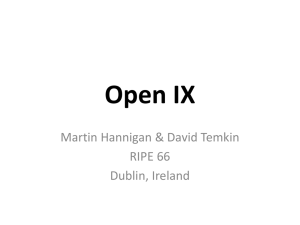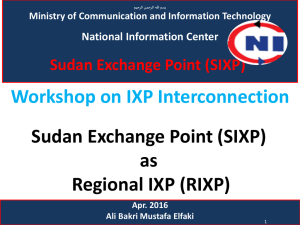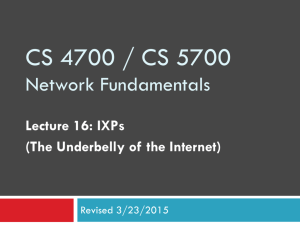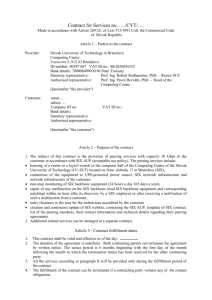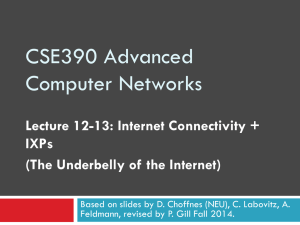MAPPING PEERING INTERCONNECTIONS TO A FACILITY Vasileios Giotsas Georgios Smaragdakis
advertisement
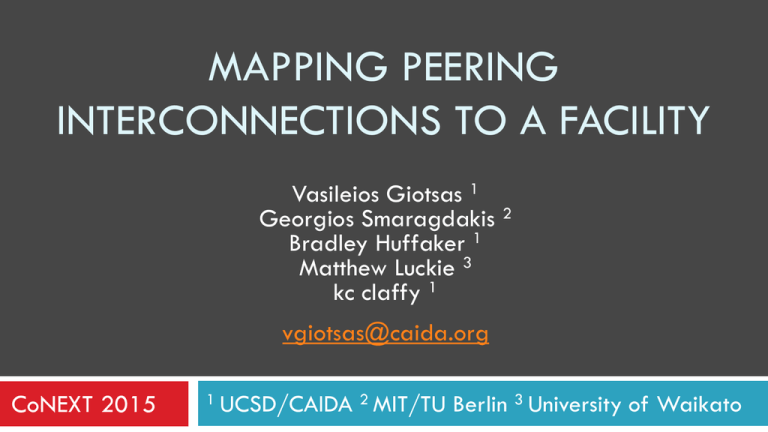
MAPPING PEERING INTERCONNECTIONS TO A FACILITY Vasileios Giotsas 1 Georgios Smaragdakis 2 Bradley Huffaker 1 Matthew Luckie 3 kc claffy 1 vgiotsas@caida.org CoNEXT 2015 1 UCSD/CAIDA 2 MIT/TU Berlin 3 University of Waikato The AS-level topology is too coarse for complex networking problems 2 AS 2 AS 1 AS 3 The building-level topology captures rich semantics of peering interconnections 3 AS 1 LINX London Equinix LD4 Telecity HEX67 Telecity HEX67 AS 2 Telehouse East London New York Coresite NY1 InterXion 3 DECIX Paris Equinix FR5 InterXion 1 IT Gate InterXion 2 Equinix 1 Paris FRA IX NewColo Torino Frankfurt AS 3 Motivation 4 Increase traffic flow transparency Assessment of resilience of peering interconnections Diagnose congestion or DoS attacks Inform peering decisions Elucidate the role of colocation facilities, carrier hotels, and Internet exchange points (IXPs) Challenges 5 IP addresses are logical and region-independent BGP does not encode geographic information Existing methods are accurate for city-level granularity, not for finer granularities: Delay-based Hostname heuristics Database-driven What buildings do we need to consider for locating peering interconnections? 6 Interconnection facilities: special-purpose buildings used to co-locate routing equipment What buildings do we need to consider for locating peering interconnections? 7 Interconnection facilities: special-purpose buildings used to co-locate routing equipment Key Intuition 1: To locate a peering interconnection, search the facilities where the peers are present Develop a map of interconnection facilities 8 Compile a list of interconnection facilities and their address Map ASes and IXPs to facilities Public data sources: PeeringDB AS/IXP websites April 2015 Facilities 1,694 ASes 3,303 AS-facility connections 13,206 IXPs 368 IXP-facility colocations 783 Interconnection facilities are concentrated in hub cities 9 Complexity of peering interconnections 10 Remote public peering Complexity of peering interconnections 11 Remote publicIntuition Key peering 2: The different peering interconnection types can be used as constrains in the facility search Constrained Facility Search (CFS) 12 For a target peering interconnection ASA- ASB: Step 1: Identify the type of peering interconnection Step 2: Initial facility search Step 3: Constrain facilities through alias resolution Step 4: Constrain facilities by repeating steps 1-3 with follow-up targeted traceroutes Step 5: Facility search in the reverse direction Constrained Facility Search (CFS) 13 For a target peering interconnection ASA- ASB: Step 1: Identify the type of peering interconnection Step 2: Initial facility search Step 3: Constrain facilities through alias resolution Step 4: Constrain facilities by repeating steps 1-3 with follow-up targeted traceroutes Step 5: Facility search in the reverse direction Identifying the peering type 14 IP1 IP3 IP2 AS A AS A AS B Facility search between the facilities of the peering Ases Private peering IP1 IP3 IP2 AS A IXP X AS B Public peering Facility search between the IXP and the peering ASes Constrained Facility Search (CFS) 15 For a target peering interconnection ASA- ASB: Step 1: Identify the type of peering interconnection Step 2: Facility search Step 3: Constrain facilities through alias resolution Step 4: Constrain facilities by repeating steps 1-3 with follow-up targeted traceroute Step 5: Facility search in the reverse direction Facility search: single common facility 16 IPA1 IPX1 AS A IXP X Near end peer IPB1 AS B Far end peer Facilities AS A F1 F2 IXP X F4 F2 The common facility is inferred as the location of the interface of the peer at the near end Facility search: single common facility 17 IPA1 IPX1 AS A IXP X Near end peer IPB1 AS B Far end peer Facilities AS A F1 F2 IXP X F4 F2 IPA1 facility The common facility is inferred as the location of the interface of the peer at the near end Facility search: no common facility 18 IPA1 IPX1 AS A IXP X Near end peer IPB1 AS B Far end peer Facilities AS A F1 F2 IXP X F4 F3 No inference possible Incomplete facility dataset or remote peering Run algorithm in [Castro 2014] to detect remote peering Run traceroutes changing the target peering links Castro et al. "Remote Peering: More Peering without Internet Flattening." CoNEXT 2014 Facility search: multiple common facilities 19 IPA1 IPX1 AS A IXP X Near end peer IPB1 AS B Far end peer Facilities AS A F1 F2 F5 IXP X F4 F2 F5 Possible facilities are constrained but no inference yet Facility search: multiple common facilities 20 IPA1 IPX1 AS A IXP X Near end peer IPB1 AS B Far end peer Facilities AS A F1 F2 F5 IXP X F4 F2 F5 Possible IPA1 facilities Possible facilities are constrained but no inference yet Constrained Facility Search (CFS) 21 For a target peering interconnection ASA- ASB: Step 1: Identify the type of peering interconnection Step 2: Initial facility search Step 3: Derive constrains through alias resolution Step 4: Constrain facilities by repeating steps 1-3 with follow-up targeted traceroutes Step 5: Facility search in the reverse direction Derive constrains through alias resolution 22 Trace 1 IPA1 AS A Trace 2 IPA2 AS A Near end peer IPX1 IXP X IPB1 AS B IPC1 AS C Far end peer Facilities AS A F1 F2 F5 IXP X F4 F2 F5 Possible IPA1 facilities Facilities AS A F1 AS C F1 F2 Possible F5 IPA2 F2 facilities F3 Parse additional traceroutes containing peering interconnections of the peer at the near end Derive constrains through alias resolution 23 IPx2 Trace 1 Trace 2 IPA1 IPA2 AS A IXP x IPC1 AS C IPB1 AS B Facilities AS A F1 F2 F5 IXP x F4 F2 F5 Possible IPA1 facilities Facilities AS A F1 AS C F1 De-alias interfaces of AS A (IPA1, IPA2) F2 Possible F5 IPA2 F2 facilities F3 Derive constrains through alias resolution 24 IPx2 Trace 1 Trace 2 IPA1 IPA2 AS A IXP x IPC1 AS C IPB1 AS B Facilities AS A F1 F2 F5 IXP x F4 F2 F5 IPA1 & IPA2 facility Facilities AS A F1 F2 F5 AS C F1 F2 F3 If two interfaces belong to the same router, find the intersection of their possible facilities Derive constrains through alias resolution 25 IPx2 Trace 1 Trace 2 IPA1 IPA2 AS A IXP x IPB1 Facilities AS B IPC1 AS A F1 F2 F5 IXP x F4 F2 F5 IPA1 & IPA2 facility AS C Multi-purpose router Used to establish both private and public peering Facilities AS A F1 F2 F5 AS C F1 F2 F3 Constrained Facility Search (CFS) 26 For a target peering interconnection ASA- ASB: Step 1: Identify the type of peering interconnection Step 2: Initial facility search Step 3: Constrain facilities through alias resolution Step 4: Constrain facilities by repeating steps 1-3 with follow-up targeted traceroutes Step 5: Facility search in the reverse direction Follow-up CFS iterations 27 Trace 1 IPA1 AS A IPX1 IXP X IPB1 AS B Facilities AS A F1 F2 F5 IXP X F4 F2 F5 If CFS has not converged to a single facility: Execute a new round of traceroutes with different set of targets Repeat steps 1-3 (a CFS iteration) ‘Clever’ selection of the new traceroute targets can help CFS to narrow down the facility search Traceroute target selection 28 Trace 1 Trace 2 IPA1 IPX1 IPB1 AS A IXP X AS B IPA3 IPX1 IPD1 AS A IXP X AS D Facilities AS A F1 F2 F5 IXP X F4 F2 F5 Facilities AS A F1 F2 F5 IXP X F4 F2 F5 Traceroute target selection 29 Trace 1 Trace 2 IPA1 IPX1 IPB1 AS A IXP X AS B IPA3 IPX1 IPD1 AS A IXP X AS D Facilities AS A F1 F2 F5 IXP X F4 F2 F5 Facilities AS A F1 F2 F5 IXP X F4 F2 F5 Targeting public peerings over the same IXP offers no additional constrains because CFS still compares the same sets of facilities Traceroute target selection 30 Trace 1 IPA1 AS A Trace 3 IPA4 AS A IPX1 IXP X IPE1 AS E IPB1 AS B Facilities AS A F1 F2 F5 IXP X F4 F2 F5 Facilities AS A AS E F9 F1 F2 F5 F1 F2 F5 Traceroute target selection 31 Trace 1 IPA1 AS A Trace 3 IPA4 AS A IPX1 IXP X IPE1 AS E IPB1 AS B Facilities AS A F1 F2 F5 IXP X F4 F2 F5 Facilities AS A AS E F9 F1 F2 F5 F1 F2 F5 Targeting private peers or IXPs with presence in all the possible facilities for IPA1 does not offer additional constrains Traceroute target selection 32 Trace 1 IPA1 AS A Trace 3 IPA5 AS A IPX1 IXP X IPE1 AS F IPB1 AS B Facilities AS A F1 F2 F5 IXP X F4 F2 F5 Facilities AS A AS E F1 F2 F5 F2 F6 Traceroute target selection 33 Trace 1 IPA1 AS A Trace 3 IPA5 AS A IPX1 IXP X IPE1 AS F IPB1 AS B Facilities AS A F1 F2 F5 IXP X F4 F2 F5 Facilities AS A AS E F1 F2 F5 F2 F6 Targeting peers or IXPs with presence in at least one but not in all the possible facilities for IPA1 can offer additional constrains (depending on alias resolution) Constrained Facility Search (CFS) 34 For a target peering interconnection ASA- ASB: Step 1: Identify the type of peering interconnection Step 2: Initial facility search Step 3: Constrain facilities through alias resolution Step 4: Constrain facilities by repeating steps 1-3 with follow-up targeted traceroutes Step 5: Facility search in the reverse direction Facility inference for the far-end peer 35 35 IPA1 IPX1 IPB1 AS A IXP X AS B Facility 2 Facility 3 or Facility 4 ? Facility search for the peer at the far-end may not converge to a single facility Last resort: switch proximity heuristic Switch proximity heuristic 36 Inferred facility Candidate facility Candidate Facility Projecting the facilities on the IXP topology can help us reason about the actual facility of the peer at the far end Switch proximity heuristic 37 Inferred facility Candidate facility Candidate Facility Preferred route Alternative route IXPs prefer to exchange traffic over the backhaul switches instead of the core if possible Switch proximity heuristic 38 Inferred facility Inferred facility Candidate Facility Preferred route Alternative route We infer the facility of the far-end peer to be the one most proximate to the facility of the near-end peer Evaluation 39 Targeted the peerings of 5 CDNs and 5 Tier-1 ASes: Google (AS15169), Yahoo (AS10310), Akamai (AS20940), Limelight (AS22822), Cloudflare (AS13335) NTT (AS2914), Cogent (AS174), Deutsche Telekom (AS3320), Level 3 (AS3356), Telia (AS1299) Queried one active IP per prefix for each of their peers Executed 100 iterations of the CFS algorithm Collecting traceroute paths 40 Combine traceroute platforms to maximize coverage: Active: RIPE Atlas, Looking Glasses (LGs) Archived: CAIDA Ark, iPlane RIPE Atlas LGs iPlane Ark Total Unique VPs 6,385 1,877 147 107 8,517 ASNs 2,410 438 117 71 2,638 160 79 35 41 170 Countries CFS inferred the facility for 70% of collected peering interfaces 41 10% of the inferences validated to 90% correctness 42 Ongoing and future work 43 Extend the facility dataset Collaborate with the operational community Utilize third-party datasets e.g. UW Internet Atlas1 Combine geolocation methods to further constrain facilities in unresolved cases Integrate CFS with CAIDA’s Ark and Sibyl2 1 http://internetatlas.org/ 2 https://www.caida.org/workshops/aims/1503/slides/aims1503_katzbassett1.pdf Conclusions 44 Constrained Facility Search (CFS) maps peering interconnections to facilities based on public data: Traceroute paths Interconnection facility maps Evaluated CFS for 5 large CDNs and Tier-1 Ases Pinpoint 70% of collected IP interfaces Validated 10% of inferences to ~90% correctness Additional results 45 ASes and IXPs are present at multiple facilities 46 Facility data in PeeringDB are incomplete 47 We compared the facility information between PDB and NOCs for 152 ASes: 2,023 AS-to-facility connections in PDB 1,424 AS-to-facility connections missing from PDB involving 61 ASes Majority of interconnection facilities are located in Europe and North America 48 April 2015 Europe 860 North America 503 Asia 143 Oceania 84 South America 73 Africa 31 Diverse peering strategies between CDNs and Tier-1 ASes 49 CDNs Tier-1s CDNs Tier-1s CDNs Tier-1s CDNs Tier-1s Missing facility data affect the completeness of CFS inferences 50
